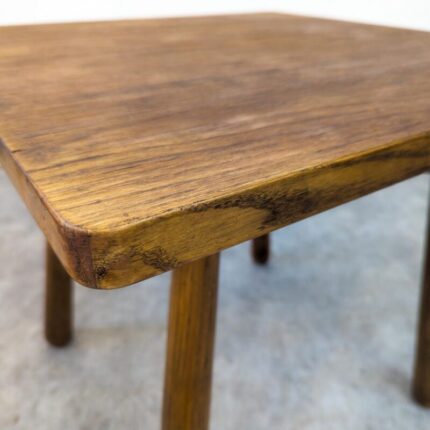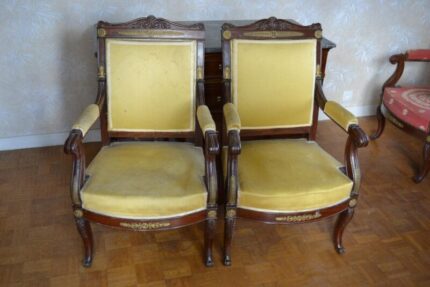Extremely rare Japonism “Folded” Fruit Bowl from the famous service “Rousseau-Bracquemond”, a similar folded fruit bowl is kept at the French Musée d’Orsay ( OAO1094).
This piece belongs to this world-known service which is present in many museums such as the Victoria & Albert Museum, the Musée d’Orsay, Petit Palais Museum, Metropolitan NY Museum, and Occidental art Tokyo Museum and. Made in fine earthenware, the service has a blue combed decoration on the wing and drawings of animals after Japanese engravings by Felix Bracquemond inspired by Hokusaï.
Here, the fruit bowl is decorated with butterflies, cicadas, bees, poppy flowers, and several birds. This combination of patterns is unique, typical of each piece from the Rousseau-Bracquemond service. Indeed, its mode of production was revolutionary: about 260 etchings were ordered by the merchant-publisher François-Eugène Rousseau to artist Félix Bracquemond and then the printing of the drawings in black, according to a ternary rhythm, was done in a random way on french Creil & Montereau faience pieces. The coloring was then hand-done freely by the workers, making each piece unique.
As soon as it was presented at the World’s Fair of 1867, this service met an unprecedented commercial success and was emblematic of the remarkable vogue for Japonism from the second half of the 19th century.
This very special folded piece was produced between 1866 and 1875. It wears all the marks beneath, “Creil / LM&Cie / Montereau / Modèle / Rousseau / à / Paris”.
This piece belongs to this world-known service which is present in many museums such as the Victoria & Albert Museum, the Musée d’Orsay, Petit Palais Museum, Metropolitan NY Museum, and Occidental art Tokyo Museum and. Made in fine earthenware, the service has a blue combed decoration on the wing and drawings of animals after Japanese engravings by Felix Bracquemond inspired by Hokusaï.
Here, the fruit bowl is decorated with butterflies, cicadas, bees, poppy flowers, and several birds. This combination of patterns is unique, typical of each piece from the Rousseau-Bracquemond service. Indeed, its mode of production was revolutionary: about 260 etchings were ordered by the merchant-publisher François-Eugène Rousseau to artist Félix Bracquemond and then the printing of the drawings in black, according to a ternary rhythm, was done in a random way on french Creil & Montereau faience pieces. The coloring was then hand-done freely by the workers, making each piece unique.
As soon as it was presented at the World’s Fair of 1867, this service met an unprecedented commercial success and was emblematic of the remarkable vogue for Japonism from the second half of the 19th century.
This very special folded piece was produced between 1866 and 1875. It wears all the marks beneath, “Creil / LM&Cie / Montereau / Modèle / Rousseau / à / Paris”.
-
Creator:Félix Bracquemond (Artist),Creil et Montereau(Manufacturer),François-Eugène Rousseau(Maker)
-
Dimensions:Height: 5.12 in (13 cm)Diameter: 10.44 in (26.5 cm)
-
Style:Aesthetic Movement(In the Style Of)
-
Materials and Techniques:FaienceGlazed
-
Place of Origin:France
-
Period:Late 19th Century
-
Date of Manufacture:1866-1875
-
Condition:GoodWear consistent with age and use.
-
Seller Location:Paris, FR
-
Reference Number:Seller: AA03526/00Seller: LU4694129607812
Reviews (0)





























Reviews
There are no reviews yet.